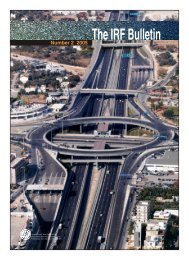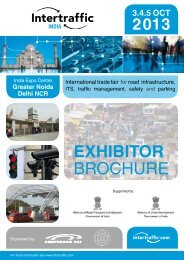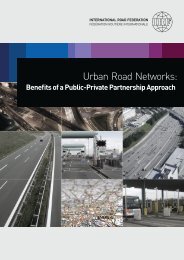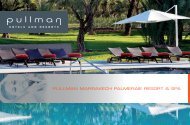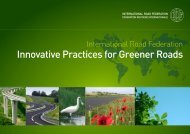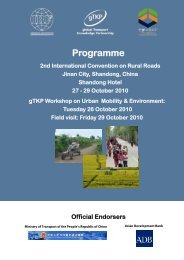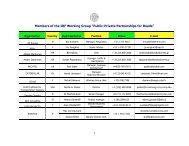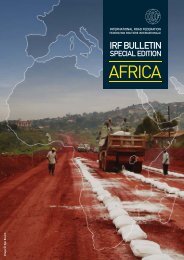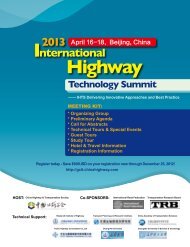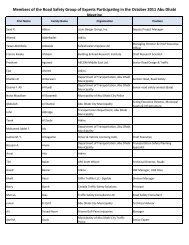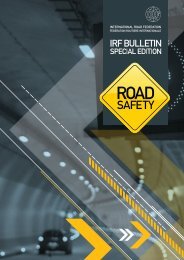TRANSPORT
TRANSPORT
TRANSPORT
- No tags were found...
Create successful ePaper yourself
Turn your PDF publications into a flip-book with our unique Google optimized e-Paper software.
SOCIO-ECONOMIC BENEFITS<br />
The ownership of motorcycles is restricted to the relatively<br />
better off sections of society, although all travellers benefit<br />
from the lower prices. The operators (not owners) are<br />
youths who find this an avenue for obtaining income. Still,<br />
the improved quality and increased maintenance on the<br />
project roads allows these intermediate means to be used<br />
to a much greater extent – and road safety issues are now<br />
becoming increasingly important.<br />
Passenger and Cargo Volumes<br />
With the road improvement, both passenger and cargo<br />
volumes increased – with motorised modes substantially<br />
increasing their share of passengers. The proportional<br />
change in passenger and cargo volumes between the<br />
baseline and ex-post surveys shows passenger numbers<br />
and cargo volumes increased by 44% and 17% respectively<br />
on the project roads; while the deterioration of the road<br />
condition on the control roads led to a 20% reduction.<br />
Cargo volumes increased by 17% on the improved<br />
roads and dropped 87% on control roads, again mostly<br />
attributable to a decline in the cargo transported by<br />
motorised means.<br />
Proportional Changes in Passenger and Cargo Traffic<br />
Change in Passenger and Cargo Tariffs<br />
Passenger Cargo Net mass movement<br />
Nominal prices<br />
Project 59% 83% 67%<br />
Control 89% 26% 58%<br />
Overall 76% 55% 62%<br />
Real Prices<br />
Project 15% 32% 21%<br />
Control 36% -9% 14%<br />
Overall 27% 12% 17%<br />
(e.g. from headloading to motorised). Indeed, we already<br />
know an overall modal shift to motorised transport has<br />
occurred. In addition, more detailed analysis of passenger<br />
and cargo tariffs indicates that there has been an overall<br />
reduction in tariffs for specific modes on the improved<br />
road corridors. While individual journey tariffs have come<br />
down, more people now travel by motorised modes on the<br />
improved roads – thus increasing the average cost of travel<br />
per km and cargo transport per tonne-km (ignoring the<br />
50%<br />
44%<br />
30%<br />
17%<br />
10%<br />
-10%<br />
-30%<br />
-50%<br />
-70%<br />
-90%<br />
Project<br />
-20%<br />
Control<br />
-87%<br />
Passenger<br />
Cargo<br />
Passenger and Cargo Tariffs<br />
The situation with passenger and cargo tariffs is difficult to<br />
interpret. While individual costs for particular journeys and<br />
some modes have reduced on project roads in real terms,<br />
overall average tariffs on improved roads have risen faster<br />
than prices on control roads.<br />
Following transport improvements, the costs to users<br />
should reduce. In this case, however, actual average tariffs<br />
have increased. This could either be because transport<br />
operators have not passed the benefits on to consumers<br />
(due to monopoly or cartel behaviour) or because there has<br />
been an overall shift to more expensive modes of transport<br />
IRF BULLETIN SPECIAL EDITION: RURAL <strong>TRANSPORT</strong>, VOLUME-2 |<br />
13



